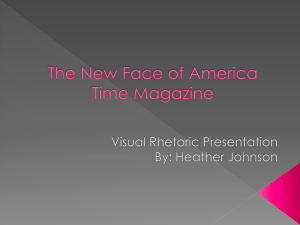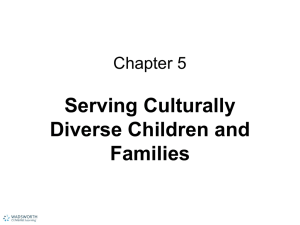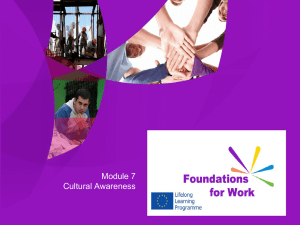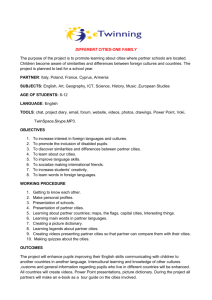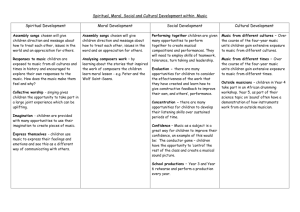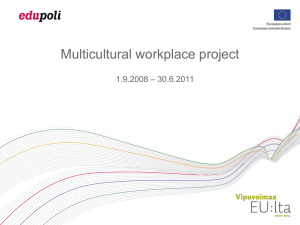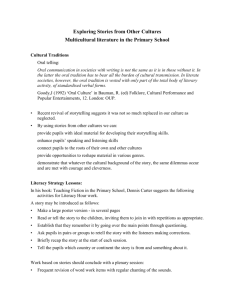The Authors: - Helsingin yliopisto
advertisement
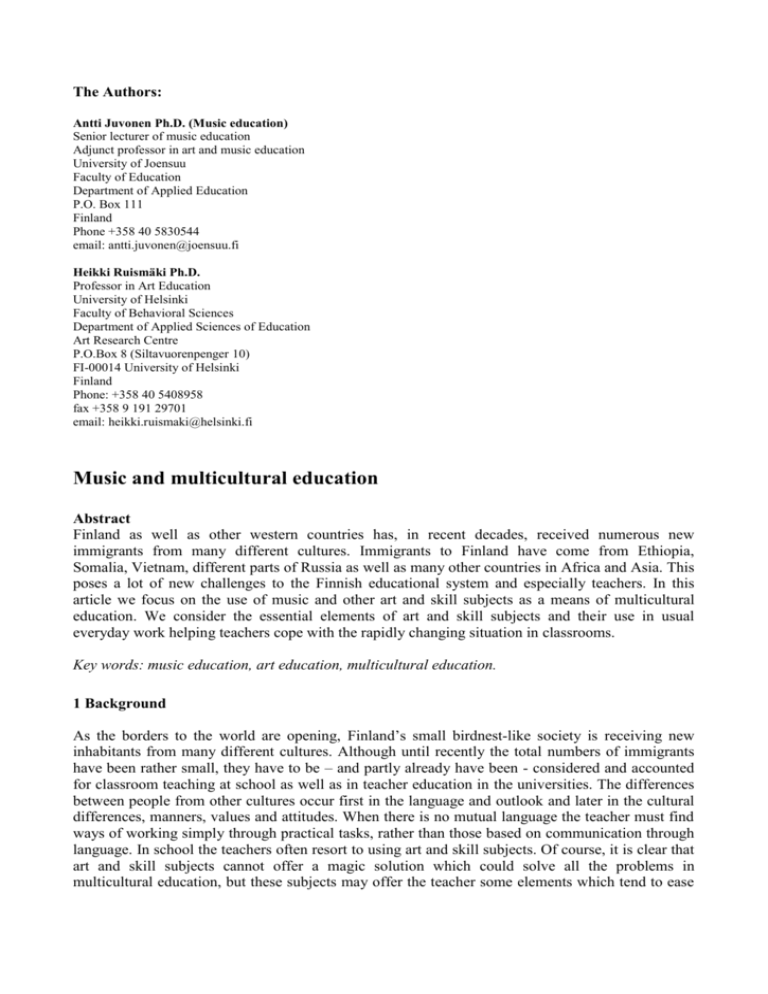
The Authors: Antti Juvonen Ph.D. (Music education) Senior lecturer of music education Adjunct professor in art and music education University of Joensuu Faculty of Education Department of Applied Education P.O. Box 111 Finland Phone +358 40 5830544 email: antti.juvonen@joensuu.fi Heikki Ruismäki Ph.D. Professor in Art Education University of Helsinki Faculty of Behavioral Sciences Department of Applied Sciences of Education Art Research Centre P.O.Box 8 (Siltavuorenpenger 10) FI-00014 University of Helsinki Finland Phone: +358 40 5408958 fax +358 9 191 29701 email: heikki.ruismaki@helsinki.fi Music and multicultural education Abstract Finland as well as other western countries has, in recent decades, received numerous new immigrants from many different cultures. Immigrants to Finland have come from Ethiopia, Somalia, Vietnam, different parts of Russia as well as many other countries in Africa and Asia. This poses a lot of new challenges to the Finnish educational system and especially teachers. In this article we focus on the use of music and other art and skill subjects as a means of multicultural education. We consider the essential elements of art and skill subjects and their use in usual everyday work helping teachers cope with the rapidly changing situation in classrooms. Key words: music education, art education, multicultural education. 1 Background As the borders to the world are opening, Finland’s small birdnest-like society is receiving new inhabitants from many different cultures. Although until recently the total numbers of immigrants have been rather small, they have to be – and partly already have been - considered and accounted for classroom teaching at school as well as in teacher education in the universities. The differences between people from other cultures occur first in the language and outlook and later in the cultural differences, manners, values and attitudes. When there is no mutual language the teacher must find ways of working simply through practical tasks, rather than those based on communication through language. In school the teachers often resort to using art and skill subjects. Of course, it is clear that art and skill subjects cannot offer a magic solution which could solve all the problems in multicultural education, but these subjects may offer the teacher some elements which tend to ease the situation in his/her difficult work. In this article we consider the issue mainly through music although many of the ideas can easily be adapted to other art and skill subjects at school. 2 Music and cultures As a child grows and is socialised to his/her own culture, a natural enculturation process occurs through which he/she adapts and learns the typical elements, manners of behaviour, values and attitudes of his/her own culture (see e.g., Pieridou-Skoutella 2007). This is also how music culture is adopted and learned. People who see themselves as a part of some special community or group adopt a common basic worldview through social interaction. In the socialisation processes typical cultural schemas develop through which an individual organises knowledge and foresees the situations everything based on previous cultural experiences (Kramsch 1998, 6, 27; Berger et al. 1994; Abril 2006). Thus, culture may be seen as intrinsic psychic, learned programming which separates groups of people and different classes from each other. The individual’s world of values, behaviour and the way of thinking are broadly based on this learned apparatus (see Talib 1999; Paavola 2007). Through the socialisation processes an individual adopts values, beliefs and traditions. He/she pieces together a subjective and objective reality of the world. A successful socialization process binds an individual tightly in his/her own culture and shows place in society (Mikkola 2001, 39). The individual’s conception about “who” he/she is (cultural identity) strengthens through the continuing interactive relationship with his own community and culture. Cultural identity and its formation process continue throughout life. Experience is a changing power in cultural identity issues. The enculturation processes in music and language are alike. A child implicitly builds through growing and learning ideas about what music is, why there is music, what music is good and what is bad, when music is used and what the meaning of music is. This way each culture builds meanings for its own music, a child adopts the musical language and the intonations as well as rhythms which are typical in his/her own culture. A culture may be considered as a system of axiomatic and self explanatory elements which separate different groups from each other and which can not be understood until it collapses another similar system (Tiittula 1997, 33). Hammond (2006) aptly states, that many of us (students, teachers, scholars, etc.) become so focused on one subject or even one aspect of a subject that knowledge from the periphery is simply overlooked, even neglected. By taking the time to study the music of another culture in depth, we open the window of opportunity for even more information from the periphery to enlighten our approaches to study, instruct and research. This cultural awareness helps remind us of the diversity of world music cultures and its importance in an age when many different cultures mingle and are very accessible to everyone. To each of us all music is a similar system of axiomatic self-explanatory elements because we have been socialised and enculturated in just the music which is typical of our society and culture. This means that the differences and collisions are more clearly seen as different music cultures meet each other. Exactly for this reason the old and over-used cliché “music is a common language for all the people” is basically untrue although the worldwide media has made some music styles and genres common to many peoples and continents. The starting point must still be that every culture has its own personal and individual music culture including elements which do not exist anywhere else in the same combination (compare Legette 2003). This is the issue to which David J. Elliott has referred when he noticed that every musical style has its own group of listeners (Elliott 1995, 8489). Elliott’s idea is also applicable to smaller musical styles: for example, speed metal has found its listeners dividing in many different countries and cultures. These kinds of special groups keep in touch with each other through the Internet easily. Thus, multiculturalism in music is sometimes built from inside the music style which may open totally new possibilities for a skilful music educator working in a multicultural environment in music education. Music education in Finland is, due to changes in education, curriculum, society and culture, built on western artistic music and even more nowadays on western pop and rock music genres. Also the major part of European and North American music education is based on the western music tradition. (See Johnson & Bob 2004; Volk 2004.) This may cause problems in Europe in the future: as multicultural education becomes increasingly indispensable there will surely be a need for other than western tradition music. For example, the music cultures of African-origin cultures differ strongly from western music culture both in expression and intrinsic meanings. Anderson and Campbell (1989) see the important elements for multicultural education in music as follows: 1. The pupils will learn numerous different musical sounds from all over the world. As the number of musical experiences rises and becomes more many-sided they notice the richness of sounds in the world. They are guided through more experiences to become even more amenable to different ways of expression in music and other arts. 2. Pupils learn to understand that there are several civilised musical realities besides their own. In the modern world which is combined by media music teachers are also beginning to understand that the western music tradition is only one of several musical cultural systems. This was noticed much earlier by performers and music makers. 3. Pupils find new ways of making music. They notice that other music cultures have many different principles in building musical performances and compositions compared to their own. The learning of the intrinsic logic in these systems is also most important when students think about their own musical ideas and realise them to music. It is also important to know the conceptions used by different cultures as the western terminology only suits the western field of music culture. 4. Pupils build poly-musical skills. Their abilities improve, they learn to listen and appreciate different music together with their ability to tolerate foreign musical elements. This means that they learn new singing and instrument playing techniques. Thus, western music can also be experienced in a new way. We notice that a large part of the music which we call European music culture has originated from many different cultures through mixing together through the centuries. This is true with all the different sectors of culture. Musical multiculturalism has been part of everyday life since ancient times. According to Campbell (1996, 15), multicultural music education is the study of music from groups distinguished by race or ethnic origin, age, class, gender, religion, life style and exceptionality. World music education is described too as the theoretical and practical study of diverse musical genres and styles from around the world (Fung 1995; Okun 1998; Reimer 1993; Schippers 1996). In Finnish basic teaching curriculum one of the aims is to help pupils understand that music is tied to time and location. It is different at different times and in different cultures and societies and it has different meanings to different people. Music education also aims to give the pupils help and advice in building their own musical identities in a process which possibly grows an appreciative and curious attitude towards different music cultures and music styles (OPS 2004). 3 Adapting to a culture Nieto (1999, 48; 2007) says that culture is a complex conception which includes the contents (what is culture?), the process (how is it built or created?) and the actors of it (who created and formed it?). The simplification of culture as only clothes, music, folk dance, national celebration days or foods or spices is the worst banality although all the mentioned issues are important elements of cultures. All over the world people create and act as a part of social and political relationships not depending on skin colour, religion, social class, sex or any other circumstances. This means that they all also have their own culture. (Nieto 1999, 48; 2007.) We mention acculturation when we have to adapt a foreign culture, just as when the immigrants are adapting to our culture and integrating into our society. As a process the acculturation means slow processes through which there will be changes in the individuals who are in touch with other cultures. These processes take place in beliefs, emotions, feelings, attitudes, values, and behaviour and identification schemas. In this process (Berry et al. 2002; Liebkind 1994) five steps have been mentioned: 1) Conformative stage (Everything in the new culture is seen good and everything in own culture is seen as bad); 2) Conflict stage (The individual knows that both cultures have their good and bad sides); 3) Submerging stage (Only one’s own culture is good, the main culture is deficient); 4) The self-examination stage (Critical discoveries also from elements of own culture); 5) Bicultural stage (Appreciating parts of both cultures. Being proud of one’s own roots but appreciative of own independence). These stages do not automatically follow each other because the situation is always changing. Often the immigrant culture is discussed as a discrete phenomenon from the society, something which can be carried along and which stays the same despite the circumstances or environment outside. (Lepola 200, 22.) Still, when different cultures meet, unrelated parts and markings may receive new meanings or even change (Liebkind 1994, 22). It is the same within the music culture. A good example of the change of meanings is seen in the rising popularity of so-called world music (Angelin tytöt, Värttinä, Kimmo Pohjonen, Miia Kalaniemi). The genre was born in recent decades and the conception “world music” is used all over the world although it originally was invented by music dealers. World music –in this case - connects the elements of pop and rock music with the folk music tradition, Lappish joiku, and old Carelian tunes together with the traditional instruments like the kantele. Especially popular (at the point of writing this article) in Finland is the artist Lauri Tähkä and his group Elonkerjuu who have succeeded in connecting folk music elements and ideas from western Finland to modern pop-rock music. Something similar took place in the end of the 1960’s in the rock genre in England and the US as folk rock was born. Electric guitars were taken in traditional folk music songs which caused much emotion among the listeners. The same idea can also be seen in the blending of eastern melodies in new western pop songs. In many areas of culture it is very difficult to differentiate what is really original Finnish culture and who represents the real Finnish ideas. In music the language separates easily the Finnish songwriters from outsiders although the back-up music and the melodies might be totally international with no signs of the Finnish tradition. Also the question rises if the music of the Finnish Roma people really is Finnish music and culture when they sing the songs in their own Roma language. The meaning of the language in multicultural music education is especially important. Learning songs may be one way to learn the words of a new language and singing together might, on the other hand, offer the immigrant some kind of relief if he, for example, has an opportunity to teach the songs of his/her own culture to the new group. Acculturation to a music culture demands the learning of the prevailing tuning and scales as well as the rhythmic idioms. This can be difficult especially if the matter is about reconciliation of two totally different musical cultures. The western musical scale system differs significantly from those in Asian or African countries. Also the meanings and the use of music have many differences. If we think for example the immigrants who come from Ethiopia or Somalia it is easy to see that their changes in acculturating in Finnish music culture are very low. In Ethiopian music culture there are more than 200 different patois or languages (Kassaya 2002). Every language and tribe area has its own typical music cultural features and habits along with the scale systems and spoken languages. On the other hand, the multinational pop culture has reached, thanks to the media, most distant corners of the world which also offers some ways to find mutual working channels in music education and music culture area (compare Miralis 2003). In the Finnish teacher education programmes, the learning of foreign music scale systems is often limited to learning pentatonic scales and eastern scales which are used in some desert-subject songs. Together with the scale systems the rhythm patterns and their use is completely different in different cultures. This has led to the beginning of new music types and genres as the cultures have mixed with each other as in blues, jazz and rock. Acculturating into a new culture may become difficult and oppressive because the process means changes in beliefs, emotions, attitudes, behaviour and through them in building the whole identity for the individuals (immigrants) who come in touch with another culture. Music culture also reflects all the mentioned issues. Contact may cause changes in both involved cultures, but usually it is the newcomer culture which changes more than the host culture. (Liebkind 1994, 25.) When the identity of the immigrants is being taken into account, the focus in integrating is on equality, interaction and mutual respect (Ruusunen 1998, 17). This respect should cover also music culture as it is known that criticising someone’s musical taste means criticising the other’s personality. The cultural knowledge which is adapted implicitly and which belongs in many respects inside procedural knowledge (silent knowledge) includes very strong value loadings and emotionally connected psychic investments. This is why the teaching should be exceptionally sensitive and it should take into account the different points of view in values, attitudes and emotions always respecting individual differences. Music, as in all the other art and skill subjects operates in the field of procedural knowledge; the method is mostly “learning by doing”. This is why they as school subjects are most adaptable in multicultural teaching. In the Finnish universities’ teacher education programmes, the emotional factor is always present: when singing or playing instruments the original nature of the song is always expressed through the feelings of the song. Also (see Belz 2006) music theory teaching includes elements, which can be seen to express multiculturalism: when learning triad chords or minor and major 7-chords the examples are often chosen from many different music styles all over the world such as Argentinean tango, British and US pop and rock music, jazz standards, many kinds of folk music from different countries and traditional dance music. It is possible especially in music education to achieve the issues mentioned earlier (equality, interaction and mutual respect) through giving up the traditional conceptions about teaching and learning where the teacher always offers the knowledge and the pupils try to learn the ideas. In a multicultural classroom the starting point might be the multicultural pupils themselves and their knowledge about different music cultures and using them as teachers for learning music and songs from their original culture. If a genuine interest is shown to immigrant’s music culture for example through learning songs from the original culture the traditional learning conception is turned upside down: the teacher becomes one of the pupils as he/she also tries to learn the new music and songs as well as a new language together with the other pupils. This situation is tailor-made to take away prejudice between the action participants as all the others understand the feelings and experiences of the immigrants as they try to adapt a new culture and a language. The immigrant pupil can also feel the strengthening of his/her own self conception as he/she can act as the adviser to the others. The activity of the group becomes co-operative because all pupils from different backgrounds have a chance in their own turn to advise the others as well as the teacher, too. The immigrants begin to adapt to the new culture little by little after the arrival in the new country. The models learned earlier do not work as they did in the former homeland. Also the attitude of the immigrant has an important meaning in the acculturation processes and integration into new culture and society. A positive attitude toward the former as well as the new culture is a prerequisite for finding one’s place in both cultural communities as well as in the multicultural community. It is natural that pupils will assist strongly in finding the balance (see Mikkola 2001, 37; Reimer 2007). For many reasons the immigrant is in the beginning forced to adapt to some features of the new culture as given, which may cause problems. If the newcomer can maintain the original culture, but still adapt to the new culture this may lead to the best outcome to a bi-cultural situation. This can be attained if the surrounding culture is open and approving enough. (Alitolppa-Niitamo 1994, 32–33.) 4 Conclusion: The meaning of art and skill subjects in multicultural education If we consider the meaning of art and skill subjects in multicultural education on a more general level, it is easy to notice the many advantages they offer compared to those for example in the science subjects. Through art and skill subjects an immigrant who does not know the new language can still gain experiences of success in a classroom. This creates the atmosphere of safety and security and permits positive feedback to the pupils. Through art and skill subjects it is possible to raise intrinsic motivation to school work as a whole on a general level. As the intrinsic motivation strengthen, the satisfaction from school work together with the feelings of competence and selfefficacy increase. Thus, all schoolwork becomes more meaningful and reasonable. At their best, the art and skill subjects offer the pupil opportunities to make their own decisions and choices which enhance the feelings of independence and control of one’s own work which all improve pedagogical wellbeing and motivation. All this is possible even though language skills may still be rudimentary. Because working in the art and skill subjects at school focuses on a procedural area of knowledge more than the area of declarative knowledge, the matter is about learning by doing things which is sometimes called skill-knowledge. (See e.g., Cunliffe 2005.) The achievement in this area also has its important therapeutic meaning and value which is often emphasised amongst those pupils who do not succeed in science or mathematic (theoretical) subjects. In this same group are also the pupils with poor language skills. The working methods in art and skill subjects deviate strongly from the usual desk-centred work in the other subjects, and although in some subjects (music, visual arts, technical works) the focus may be on producing some product or performance, it is always about social achievement where every participant gives and receives feedback and information to the others. This is how the art and skill subjects produce experiences of appreciation and accepting the foreign and new. They similarly strengthen the pupils’ self-concept. References Abril, C. 2006. Learning outcomes of two approaches to multicultural music education. International Journal of Music Education. Volume: 24 , 1, 30-42. Alitolppa-Niitamo, A. 1994. Kun kulttuurit kohtaavat - matkaopas maahanmuuttajien kohtaamiseen ja kulttuurien väliseen vuorovaikutukseen. Suomen mielenterveysseura. Sairaanhoitajien koulutussäätiö. Keuruu. Anderson, W.M. & Campbell P.S. (Toim). 1989. Multicultural Perspectives in Music Education. Music Educator’s National Conference, Reston, VA 22091. Belz, M., J. 2006. Opening the Doors to Diverse Traditions of Music Making: Multicultural Music Education at the University Level. Music Educators Journal, Vol. 92, Issue 5. Berger, B. & Luckmann, T. 1994. Todellisuuden sosiaalinen rakentuminen. Helsinki: Gaudeamus. Berry, J.W., Poortinga, Y.H., Segall M.H. & Dasen P.R. 2002. Cross-cultural psychology. (2. painos). Research and applications. Cambridge University Press. Campbell, P. S. (1993). Music instruction: Marked and moulded by multiculturalism. American Music Teacher, 42 (6), 14-17, 67-69. Cunliffe, L. 2005. The problematic relationship between knowing how and knowing that in secondary art education. International Journal of Art & Design Education, Vol. 24 Issue 2, 199-208. Elliott, D. J. 1995. Music Matters. A New Philosophy of Music Education. New York: Oxford University Press. Fung, C. V. 1995. Rationales for music teaching world musics. Music Educators Journal, 82 (1), 36-40. Hammond, T. 2006. Opening the Doors to Diverse Traditions of Music Making: Multicultural Music Education at the University Level. Music Educators Journal, Vol. 92, Issue 5. Johnson, Jr. & Bob L. 2004. A Sound Education for All: Multicultural Issues in Music Education. Educational Policy, Vol. 18 Issue 1, 116-141. Kassaya, W. 2002. Keskustelutiedonanto väitöskirjan ohjausprosessin yhteydessä. Kramsch C. 1998. Language and cultural identity. Teoksessa Language and culture. (65-84) Oxford: Oxford University Press. Legette, R. M. 2003. Multicultural Music Education. Attitudes, Values, and Practices of Public School Music Teachers. Journal of Music Teacher Education 13 (1): 51-58. Lepola, O. 2000. Ulkomaalaisesta suomenmaalaiseksi. Monikulttuurisuus, kansalaisuus ja suomalaisuus 1990-luvun maahanmuuttopoliittisessa keskustelussa. Suomalaisen kirjallisuuden seura. Helsinki: Hakapaino Oy. Liebkind, K. (Toim.) 1994. Maahanmuuttajat. Kulttuurien kohtaaminen Suomessa. Helsinki: Hakapaino Oy. Mikkola, P. 2001. Kahden kulttuurin taitajiksi. Maahanmuuttajaoppilaan monikulttuurinen identiteetti, tavoitteet ja toiminta. Turku: Painosalama Oy. Miralis, Y., C. 2003. Multicultural-World Music Education at the Big Ten Schools: A Description of Course Offerings. UPDATE: Applications of Research in Music Education, Vol. 22, Issue 1. Nieto, S. 1999. The Light in Their Eyes. Creating Multicultural Learning Communities. Teachers College. New York: Columbia University. Nieto, S. 2007. School reform and student learning: A multicultural perspective. (Teoksessa Banks J.A. & McGee Banks C.A. Toim., Multicultural Education: Issues and Perspectives 425443, 6. uudistettu pianos). Boston: Allyn & Bacon. Okun, M. (1998). Multicultural perspectives in undergraduate music teacher education programs Dissertation Abstracts International, 59 (03A), 0766. OPS 2004. http://www.oph.fi/SubPage.asp?path=1,17627,1558 (Luettu 16.10.2008) Paavola, H. 2007. Monikulttuurisuuskasvatus päiväkodin monikulttuurisessa esiopetusryhmässä. Helsingin yliopisto. Käyttäytymistieteellinen tiedekunta. Soveltavan kasvatustieteen laitos Tutkimuksia 283. Pieridou-Skoutella, A. 2007. The construction of national musical identities by Greek Cypriot primary school children – implications for the Cyprus music education system. British Journal of Music Education, 24:3:251-266. Philpott, C. & Plummeridge, C. 2001. Issues in Music Teaching. Routledge. Reimer, B. 1993. Music education in our multimusical culture. Music Educators Journal, 79 (7), 2126. Reimer, B. 2007. Roots of inequity and injustice: the challenges for music education. Music Education Research Vol. 9, No. 2, 191-204. Ruusunen, M. 1998. Maahanmuuttajat Suomessa ja heidän integroituminen yhteiskuntaan. Sisäasiainministeriön aluekehitysosaston julkaisu 5/1998. Schippers, H. 1996. Teaching world music in the Netherlands: Towards a model for cultural diversity in music education. International Journal of Music Education, 27, 16-23. Talib, M-T. 1999. Toiseuden kohtaaminen koulussa. Opettajien uskomuksia maahanmuuttajaoppilaista. Helsingin yliopisto. Opettajankoulutuslaitos. Helsinki: Hakapaino. Tiittula, L. 1997. Kulttuurien välinen viestintä. Teoksessa Pitkänen, P. (Toim.) Näkökulmia monikulttuuriseen Suomeen. Oy Edita Ab. Volk, T. 2004. Music, Education, and Multiculturalism: Foundations and Principles. New York: Oxford University Press.
